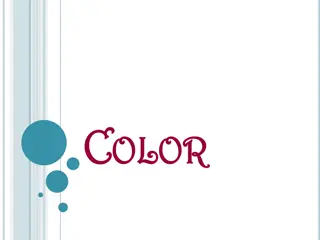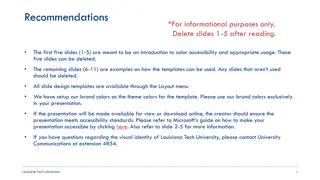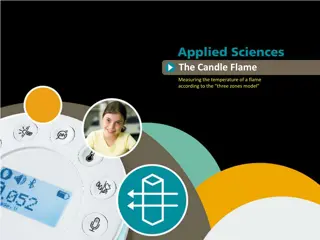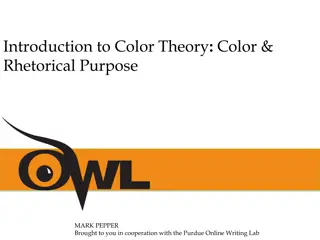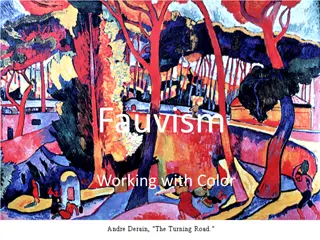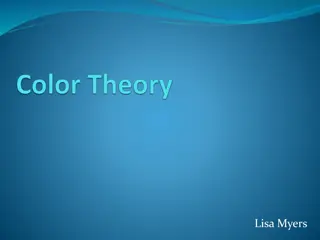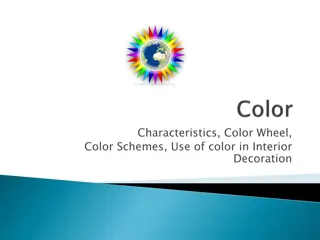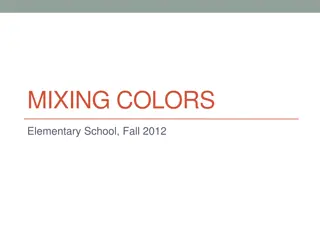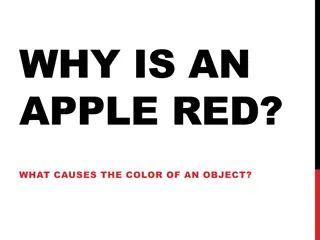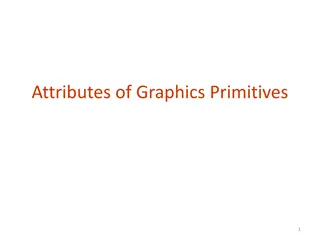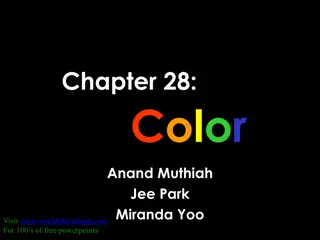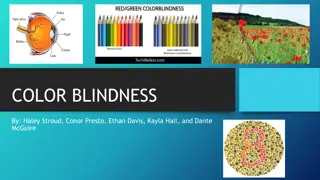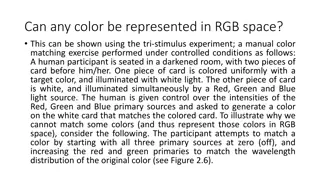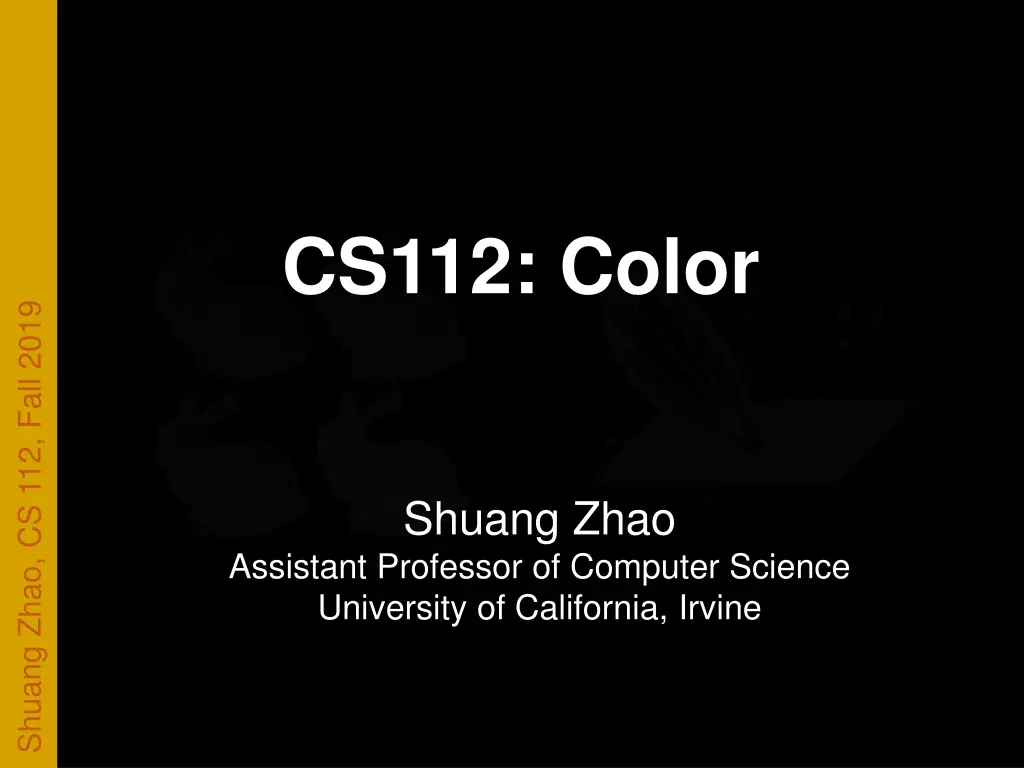
Understanding Color in Computer Graphics
Explore the world of color in computer graphics with Shuang Zhao in CS112. Topics include visible light spectrum, color stimuli, reflectance, color mixtures, and more. Gain insights into how color is due to selective emission/reflection and different eye responses to wavelengths. Prepare for the midterm exam and learn about tristimulus values and CIE functions for standard observer. Dive into the principles that govern color in digital imagery.
Download Presentation

Please find below an Image/Link to download the presentation.
The content on the website is provided AS IS for your information and personal use only. It may not be sold, licensed, or shared on other websites without obtaining consent from the author. If you encounter any issues during the download, it is possible that the publisher has removed the file from their server.
You are allowed to download the files provided on this website for personal or commercial use, subject to the condition that they are used lawfully. All files are the property of their respective owners.
The content on the website is provided AS IS for your information and personal use only. It may not be sold, licensed, or shared on other websites without obtaining consent from the author.
E N D
Presentation Transcript
CS112: Color Shuang Zhao, CS 112, Fall 2019 Shuang Zhao Assistant Professor of Computer Science University of California, Irvine
Announcements PA2 due this Wednesday at 11:59 pm Please remember to submit your work in time! (We only accept one late submission.) Midterm exam next Tuesday (Nov 12) In class, closed book Mostly about concepts and simple derivations Covers all topics up to this lecture i.e., interactive graphics pipeline, transformations, shading, Brief review on Thursday Shuang Zhao, CS112 2
Visible Light Spectrum Light is one type of electromagnetic wave Shuang Zhao, CS112 3
Color is due to.. Selective emission/reflection of different wavelengths by surfaces in the world Different response to different wavelengths of the eye Shuang Zhao, CS112 4
Illumination I() Shuang Zhao, CS112 5
Reflectance R() (Can be directionally dependent) Shuang Zhao, CS112 6
Color Stimuli C() (Can be directionally dependent) I( ) x R( ) = C( ) Shuang Zhao, CS112 7
Color Mixtures Subtractive Intersection of two spectrums C1( ) and C2( ) In paints C1( ) C2( ) Power Wavelength Shuang Zhao, CS112 8
Color Mixtures Additive Addition of two spectrums C1( ) and C2( ) In light C1( ) C2( ) Power Wavelength Shuang Zhao, CS112 9
CIE Functions for Standard Observer Shuang Zhao, CS112 10
Tristimulus Values Integration over wavelength Shuang Zhao, CS112 11
Tristimulus Values Shuang Zhao, CS112 12
Metamerism Two different color stimuli can generate same tristimulus values Metamers Evoke same response in the eye This is why RGB displays work! Shuang Zhao, CS112 13
Tristimulus Values XYZ forms a three dimensional space to define color Two colors added by just adding the XYZ coordinates Shuang Zhao, CS112 14
Tristimulus Values The intensity of x( ), y( ) and z( ) combining which would create a metamer of the spectrum Since normalized, it signifies proportions Correct upto a scaling factor Shuang Zhao, CS112 15
How does this space look? Shuang Zhao, CS112 16
Different Types of Color Monochromatic Laser Achromatic Sunlight (close to) Polychromatic Most common Shuang Zhao, CS112 17
Properties of Color Intensity Amount of stimulus in cd/m2 The absolute brightness Governed by the area under the curve Shuang Zhao, CS112 18
Properties of Color Hue Predominant wavelength Mean Shuang Zhao, CS112 19
Properties of Color Saturation Amount of achromatic light Variance from the mean All these three parameters are interrelated. Cannot be changed independently Shuang Zhao, CS112 20
How to define these using XYZ? Intensity X+Y+Z Luminance Response of the green cones Perceived Brightness Y Hue and Saturation (Chrominance) Using chromaticity coordinates Shuang Zhao, CS112 21
Chromaticity Chart Relative proportions of X, Y, and Z are more important Achromatic Color Equal proportions of X,Y and Z Chromaticity Chart 2D projection of 3D colors on X+Y+Z = d plane Plot of xandyis the chromaticity chart x = X/(X+Y+Z) y = Y/(X+Y+Z) Shuang Zhao, CS112 22
Chromaticity Chart Points on a vector originating at zero coincide at the same point (X,Y,Z) and (2X,2Y,2Z) generate same (x,y) Colors on this vector have different intensity but same chrominance Shuang Zhao, CS112 23
Chromaticity Coordinates Shows all the visible colors Achromatic Colors are at (0.33,0.33) Why? Called white point The saturated colors at the boundary Spectral Colors White Point Shuang Zhao, CS112 24
Chromaticity Chart Exception is purples Non-spectral region in the boundary All colors on straight line from white point to a boundary has the same spectral hue Dominant wavelength P White Point Shuang Zhao, CS112 25
Chromaticity Chart What happens here? Complimentary wavelength When mixed generate achromatic color Purity (Saturation) How far shifted towards the spectral color Ratio of a/b Purity = 1 implies spectral color with maximum saturation B P b B a P White Point (W) Shuang Zhao, CS112 26
How to combine colors? Using XYZ Just add them Using intensity and (x,y) Sum (x,y) weighted by proportions of their intensities to generate new (x,y) Add the intensities to generate new intensity What happens when add two colors of same hue and saturation? Only adds their intensities Shuang Zhao, CS112 27
Additive Color Generation Take three primary colors (R, G, B) Add them in different amounts to generate a color Shuang Zhao, CS112 28
2D Color Gamut Projection of 3D gamut on X+Y+Z=d plane It is a triangle on the chromaticity charts Shows reproducible the hue and saturation Examples: sRGB, aRGB, DCI-P3 Shuang Zhao, CS112 29
Different Display Devices Differs only in the primaries used Have different spectrums Can be converted to each other via a linear transformation Expressed using a 3x3 matrix Conversion between RGB and XYZ RGB is dependent on device (device dependent color space) XYZ depends on eye s response (device independent color space) Shuang Zhao, CS112 30
Display/Sensor Model ( Xg ,Yg,Zg ) Y ( Xr ,Yr ,Zr ) Device dependent X ( Xb ,Yb ,Zb ) Z Shuang Zhao, CS112 31
Linear Devices [X Y Z 1]T = M [R G B 1]T Two devices: [X Y Z 1]T = M1 [R1 G1 B1 1]T [X Y Z 1]T = M2 [R2 G2 B2 1]T [R2 G2 B2 1]T = M2-1 [X Y Z 1]T = M2-1 M1 [R1 G1 B1 1]T Is essentially a transformation of coordinates Shuang Zhao, CS112 32
Display/Sensor Model Shuang Zhao, CS112 33

